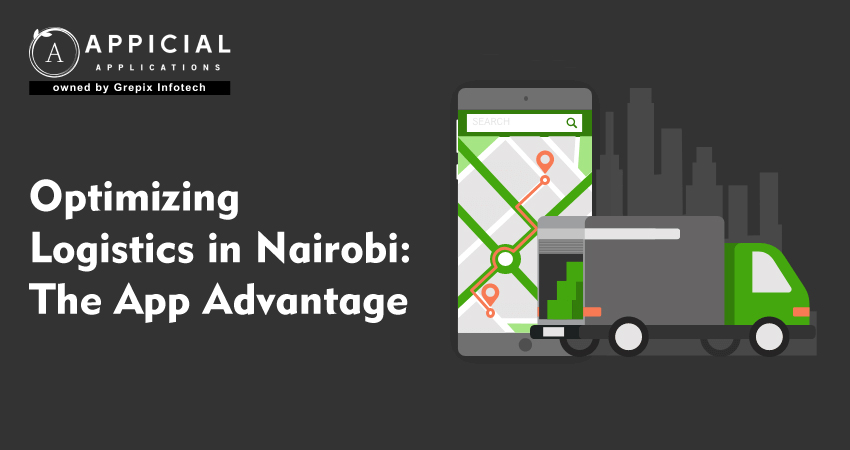
Optimizing Logistics in Nairobi: The App Advantage
Nairobi’s economy runs on movement. Every day, goods enter and exit the city. From big manufacturing facilities to tiny retailers, everybody depends on logistics to stay afloat.
But let’s face it. Moving goods across Nairobi is not always easy. Businesses struggle to meet delivery deadlines. Costs keep rising. Customers demand faster service.
This is where technology offers real help. Many companies are now turning to Nairobi logistics apps. These apps help smooth operations, cut costs, and improve delivery times. In this blog, we’ll take a close look at the challenges, the benefits of app-based solutions, success stories, and a step-by-step plan to get started.
Nairobi logistics face daily obstacles like heavy traffic, expensive prices, and security threats. But businesses are finding smart ways to tackle these issues. This blog shows how Nairobi logistics apps and logistics solutions in Nairobi are changing the game. You’ll see real success stories and get a simple plan to implement these tools. Whether you run a small delivery service or a large supply chain in Kenya, this guide helps you get started.
What are the Key Logistics Challenges in Nairobi?
Let’s begin with what makes logistics tough in this city.
- Traffic gridlock: If you’ve spent any time in Nairobi, you know traffic is a nightmare. Trucks and delivery vans waste hours stuck in jams. Fuel burns. Time gets lost. Deliveries run late. This daily gridlock hurts businesses and frustrates customers.
- Poor road infrastructure in some areas: Roads in Nairobi are not always kept up. In actuality, a lot of delivery routes go through places with potholes, constrained lanes, and inadequate signage. It takes longer for drivers to drive on these roads. Goods get delayed. Sometimes, vehicles break down more often because of the rough conditions.
- High logistics costs: Running deliveries across Nairobi costs a lot. Fuel prices are high. Vehicle repairs eat into profits. Paying drivers and managing warehouses also add up. Without a smart system, it’s hard to control these costs.
- Lack of visibility: To track deliveries, many businesses still use paperwork and phone calls. The location of goods is unclear to managers in the absence of real-time updates. Until customers complain, delays are ignored. This reactive approach keeps businesses on the back foot.
- Security risks: Cargo theft is another headache. Goods on the road, especially valuable one, are at risk. Drivers often travel alone. Without proper tracking, stolen goods are hard to recover.
What are the Benefits of App-Based Solutions?
Imagine a busy logistics manager in Nairobi. His day starts before sunrise. He checks delivery schedules. He fields calls from drivers stuck in traffic. Customers call, demanding to know when their goods will arrive. Sound familiar?
This is where Nairobi logistics app come in. These apps help businesses like his take back control. They bring clarity, speed, and real savings. Now, let’s talk about how Nairobi logistics apps change the game. These apps bring visibility, control, and cost savings.
- Real-time tracking: Picture this. Your truck leaves the warehouse at 8 a.m. It hits a jam on Mombasa Road. You don’t know this without a tracking app until the driver calls you, maybe an hour later. By then, the customer is already upset. With an app, it’s different. You see that truck on your screen. You spot the delay the moment it happens. You call the customer before they call you. You offer a new delivery window. The customer feels valued. You stay ahead of problems.
- Route optimization: Nairobi’s traffic is unpredictable. One minute, the road is clear. Next, a small accident causes gridlock. Now, imagine your app quietly working in the background. It checks traffic in real-time. It suggests a faster route before your driver even asks. Your driver avoids that jam. The goods arrive on time. You save on fuel. Your customer is happy. And you didn’t have to lift a finger.
- Smart fleet management: Your trucks are the backbone of your business. Keeping them in top shape is key. An app helps with this. It reminds you when a vehicle needs service. It alerts you if fuel use seems high. Some apps even tell you how your drivers behave. Are they braking too hard? Speeding? These small details matter. They help prevent breakdowns. They keep your fleet running safely. One manager shared how this changed his business. Before the app, he spent hours each week checking service records. Now the app handles it. His vehicles last longer. His costs are down.
- Better inventory control: Stock issues can ruin your day. Imagine promising a customer an item, only to find it’s out of stock. Or worse, finding expired stock sitting in your warehouse. Modern logistics solutions in Nairobi solve this. The app shows what’s in your warehouse at any moment. You plan better. You order just enough. You reduce waste. Your shelves stay organized. One business owner told us this: Before using an app, he lost millions to overstocking items that didn’t move. Now, he orders smarter. His cash flow is healthier.
- Reduced costs: Every business wants to save money. Apps make this easy. You coordinate deliveries without endless phone calls. You stop wasting hours on paperwork. Your vehicles need fewer repairs because you maintain them well. You burn less fuel by avoiding jams. One company we spoke to saved 20% on fuel in just three months after adding an app. That’s real money that goes back into growing the business.
- Stronger security: Cargo theft is a real threat. But apps give you tools to fight back. With geofencing, you set safe zones. Your app watches the routes for you. If a truck strays, you know at once. You call the driver. You alert security. One firm recovered a hijacked truck because the app alerted them in time. They acted fast. The goods were safe. The driver was safe. The customer got their delivery.
Also Read: Automated Dispatch Systems in Logistics App Clones for Efficiency
Case Studies Related to Nairobi Logistics Apps
Let’s look at real businesses that have seen success with Nairobi logistics apps.
- Case Study 1: A leading FMCG distributor: This company struggled with late deliveries. Customers complained. Costs kept rising. The firm adopted a smart Nairobi logistics app. They used it to plan better routes and track deliveries. In two months, delivery times improved by 35%. Fuel use dropped. Their customer satisfaction scores went up.
- Case Study 2: A growing e-commerce startup: An online retailer saw orders double but struggled to manage deliveries. Packages got delayed. Some even went missing. They turned to a logistics solution in Nairobi. The app helped assign deliveries smartly. It tracked drivers in real-time. The result? Fewer mistakes. Happier customers.
- Case Study 3: A manufacturer of high-value goods: This business faced theft of goods during transit. A logistics app with driver monitoring and geofencing was added. If a truck veered off course, managers were immediately notified. The app helped them recover one stolen truck within hours. Over time, theft cases fell by 60%. The added security also improved driver accountability.
Implementation Roadmap
So, how can you use the app to improve your logistics? Let's go over a workable plan.
- Step 1: Identify your top challenges: Look at your operations closely. Where do you lose the most time and money? Is it due to traffic delays? Is it high fuel use? Is it lost goods? List your biggest issues. This will guide your app choice.
- Step 2: Set clear, realistic goals: Choose what success means to you. Would you like a 30% shorter delivery time? Reduce fuel expenses by 15%? Improve customer ratings? Clear targets help you measure progress.
- Step 3: Explore app options: There are many Nairobi logistics apps out there. Some focus on small fleets. Others suit larger operations. Compare features. Check prices. Read reviews. Ask for demos. Choose what fits your business size and needs.
- Step 4: Train your team: An app only works if people use it well. Managers, warehouse workers, and train drivers. Don't complicate things. Demonstrate how the app facilitates their work. Offer ongoing support.
- Step 5: Start with a pilot: Test the app on one part of your fleet. Or try it on a few routes. Watch for problems. Gather feedback. Fix issues before rolling out wider.
- Step 6: Measure and adjust: Keep tracking key numbers—delivery times, costs, errors. Use the app’s reports to spot trends. Adjust your processes where needed. Stay flexible.
- Step 7: Keep updating: Tech keeps changing. Make sure your app stays current. Updates often bring useful new features. Also, listen to your team. They can help you find ways to get even more value from the tool.
Final Thoughts
Logistics in Nairobi will always have its challenges. But you don’t have to face them with old tools. Nairobi logistics apps offer real, practical help. They give you control over your fleet. They save you time and money. They keep your goods safer.
But here’s the key. You need the right partner. That’s where Appicial Applications comes in.
Appicial builds world-class logistics solutions in Nairobi and across Kenya. Their apps are designed for businesses like yours. They understand local challenges. They offer custom features that match your exact needs. Whether you run a small delivery service or a large supply chain, Appicial can help.
Thousands of businesses have already trusted Appicial to optimize their operations. They’ve seen the difference in delivery times, in cost savings, in customer satisfaction. And you can too.
So, if you’re ready to take control of your supply chain, it’s time to act. Talk to Appicial Applications today. See how their smart solutions can help you grow, compete, and succeed. Nairobi’s logistics don’t have to be a daily headache. With the right app, they can be your biggest strength.
Looking out to start your own Logistics venture? Try out our GTA Logistics app, the easiest way to kick-start your logistics business.Author's Bio

Vinay Jain is the Founder at Grepix Infotech and brings over 12 years of entrepreneurial experience. His focus revolves around software & business development and customer satisfaction.
Back to blog list




